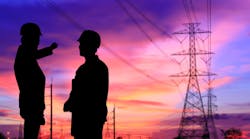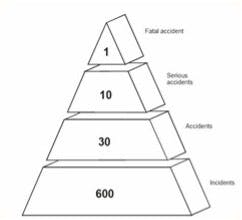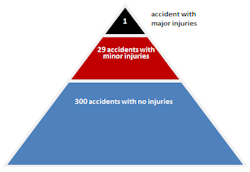Today, creating and maintaining a healthy and safe working environment is an imperative for any business. It’s a must have. This was not always the case.
As the world’s power sources evolved from animal, wind and falling water to steam and electrical energy, the linemen who once labored to bring telephone and telegraph to the rapidly expanding United States, followed a natural evolution to be the same people who helped electrify the nation. As the work became more specialized and less safe, a massive increase in the mortality rate--of up to 50%--presented new challenges and the need for these businesses to protect their workers.
The steep increase in the mortality rate was the catalyst for the creation of safe worker laws and thus began a new era in the area of health and safety. The first initiatives included the best practices and procedures that were available at the time. Since then, our ability to track, and most importantly remediate work associated safety issues has led us to a time where lineman mortality rates are significantly reduced. Over the course of a century, we have gone from limited record keeping and a culture of silence to human performance and technology platforms that enable open reporting, digitization of records, and Artificial Intelligence (AI) for informed decision making.
OSHA, BLS and EMR
With the passage of the Williams-Stagner Act, the Occupational Safety and Health Administration (OSHA) required businesses to “provide a workplace free of recognized hazards.” Now requirements such as OSHA, Bureau of Labor Statistics (BLS), and Experience Modification Rates (EMR) ensure that businesses paint a detailed picture of their involvement in the safety of their employees.
Setting the rules and regulations aside, from a practical point of view, it is good for a business to protect its employees. The perception of having a safe, or unsafe, place to work matters to the public, potential customers as well as current and potential employees and their families. Ensuring that a workplace is safe also presents the challenge of constantly updating and improving workplace health and safety programs to keep up with the latest technological and regulatory developments.
The Incident Triangle
It is easy to recognize the sources of traumatic work injury and it is important to focus on reducing their occurrence. Falls, electrical accidents, cutting and chipping equipment are all identified as hazards. They also come with rules, practices and guards that are easily compromised.
The Incident Triangle was first introduced in 1936 with the purpose of outlining the progression of accident severity. It has been replicated over the years with improved record keeping that also included incidents with little change in the ratio.
The Incident Triangle has been contested over the years by businesses that maintained it did not work for their industries. In some cases, it is true that the Incident Triangle needed to be better adapted to specific industries. Yet, we also think we can make the idea of the triangle work for every business. The base concept remains the same although the ratio for your company may vary somewhat.
How can this same triangle be developed for your company? The easiest incidents to find are those that are most serious. Look at the fatalities if you have them. How much time passes between them? For example, there was a business that suffered a fatal injury approximately every two years. It is important to look at the lost workdays and restricted duty days in that two-year period for patterns and trends.
The third level should include OSHA reportable incidents and first aid cases. The difficult part is finding the near miss incidents. Examples include inadequate or outdated PPE, improper work area protection or discovery of a non-functioning guard. This type of input should be included and will ultimately dictate how the triangle looks for your company.
We are all familiar with the requirements of the OSHA 300 report. The report was created to streamline the process of tracking and trending of serious workplace incidents. This report was a great tool in 1970. Today, with available technology, we can easily track more information than is required on the OSHA 300. What’s more is we can predict the next injury based on the career experience of the injured, the time of day, the type of work performed, hours worked, and what injured the employee. Developing a company-specific triangle can provide insight into the effectiveness of various worker safety initiatives.
Open Reporting Culture and the Power of Technology
While most companies that support the utility industry have some form of near miss reporting, many underreport these events. A narrow Incident Triangle is an indication of under reporting. It may be due to a lack of importance placed on incident reporting, a fear of drawing attention to a situation or condition, a production-focused mindset or simply because it is difficult or time consuming to do so.
One easy way to improve data collection is to simplify the process of reporting near misses. Nearly everyone owns a smart phone with a camera, has the ability to write or text, and a connection to the internet. Whether your business develops its own tool or uses one of the many off the shelf incident reporting apps available, providing a quick and easy way of reporting near misses should be a no brainer. Gone are the days of reaching into the glovebox for paper forms and a disposable camera. We now can track incidents or near misses in real time and process that data relative to location, weather, time of day, and any other set of factors that may help reveal trends that can be reversed before they develop into more serious injuries.
Human Performance and Removing Reporting Stigma
A desire to improve safety performance should be rooted in a genuine concern for the wellbeing of those around us. It should not matter whether the affected person is an employee of your company, someone working for another company, or a member of the general public; all of whom have the potential to be affected by work that is conducted on a public utility.
Newer techniques such as Human Performance (HP) based error prevention techniques help provide greater accident avoidance as the reporting includes all errors. Human performance is a work process that analyzes how actions result in mistakes and how education and relevant procedures can reduce or eliminate mistakes. Human performance principles help an individual maintain positive control of a work situation, ensuring that what is intended to happen is all that happens.
The core principles of HP are:
1. People are fallible, and even the best people make mistakes
2. Error-likely situations are predictable, manageable, and preventable
3. Individual behavior is influenced by organizational processes and values
4. People achieve high levels of performance largely because of the encouragement and reinforcement received from leaders, peers and subordinates
5. Events can be avoided by understanding the reasons mistakes occur and applying the lessons learned from past events (or errors)
In the spirit of these principles, there has been an attempt to remove the fear or stigma associated with reporting less than desirable occurrences in the field with a new, underlying goal of learning from them and ultimately preventing serious injury as opposed to simply assigning blame.
Some companies use a combination of terms such as Near Miss Incident, Good Catch or Shareable Moment to refer to the traditional concept of a near miss. The definition has been broadened by these terms to encourage sharing other learning opportunities with the entire organization. Even process improvement ideas can be shared. For example, this might include a missed step in an approved procedure, improper work area protection, or a less than comprehensive pre-job briefing. Incorporating events such as these can help tailor the triangle for your company and provide a more realistic number to be used in its base.
Technology Platform, AI, HP, and Data-Driven Decision Making Brings Results
The OSHA 300 reports that companies are required to maintain are just the start. With modern mobile technology and advanced data analytics, we have the ability to track much more information than required by the report. Armed with this additional data and using business intelligence software systems, advanced data processing, and Artificial Intelligence (AI), we can, with a high level of accuracy, hone-in on the potential next injury based on a number of factors including career experience, time of day, type of work, the number of hours worked, the weather at the time of the incident, and the nature of the injury.
Technology platforms that digitize documents for health and safety programs provide valuable automation technology for real-time project updates. AI for business intelligence can provide utilities with the required documentation to improve their health and safety programs. Today, digitally capturing data is the first important step. A good tool can increase the accuracy of information document, reduce or eliminate inaccuracies and redundancies, automate data processing, and ultimately improve to better decisions for the health and safety program.
In the early 1980’s, the primary responsibility of safety personnel was to prevent fatalities. The accident reports in the 1980’s listed “Hazard of the Job” as a cause. The “almost injury” or even “less than serious injury” was not a reportable incident. One of the best outcomes over the years has been the emphasis placed on improving the bottom of the triangle. Planning for and correcting the incidents at the bottom resulted in the top of the triangle stretching out to longer and longer periods. The two-year example between fatalities cited earlier in this article improved to three years and then to even longer spans of time between incidents. In utilizing technology platforms to examine records and data for the facts they contain, informed decision making became a valuable factor in the process of making genuine workplace safety improvements. Accident avoidance became a more-focused goal, benefiting the company and every employee who avoided injury because of research and a genuine concern for well-being.
For more information, visit https://www.thinkpowersolutions.com.




